Mitsubishi Eclipse Cross (2023 year). Manual in english - page 1

If this warning light comes on or flashes while you’re driving...
If this warning light comes on or flashes while you’re driving...
N00200702478
2
NOTE
z For information regarding warning displays in the multi-information display, refer to “Multi-information display” on page 5-144.
z These warning lights will come on for a few seconds for a bulb check when the ignition switch is first turned to “ON” or the operation mode is put in ON.
Warning lights
Do this
Ref. Page
z Park your vehicle in a safe place and stop the engine.
Contact your Mitsubishi Motors dealer or a repair facility of your choice for assis-
P. 5-188
tance immediately.
Charging system warning light
z If this light comes on while driving, check to see that the parking brake is fully
released.
z If this light stays on after releasing the parking brake, immediately stop and check
or
the brake fluid level.
P. 5-186
z If the brake fluid level is correct, there may be a system malfunction. Avoid hard
braking and high speed, and contact an authorized Mitsubishi Motors dealer or a
Brake warning light
repair facility of your choice for assistance.
z If the warning light comes on during driving, there is the possibility that the parking
brake cannot be operated or released. Immediately stop the vehicle in a safe place,
P. 5-186
and contact an authorized Mitsubishi Motors dealer or a repair facility of your
choice for assistance.
Electric parking brake warning light
(if so equipped)
Quick index
2-1
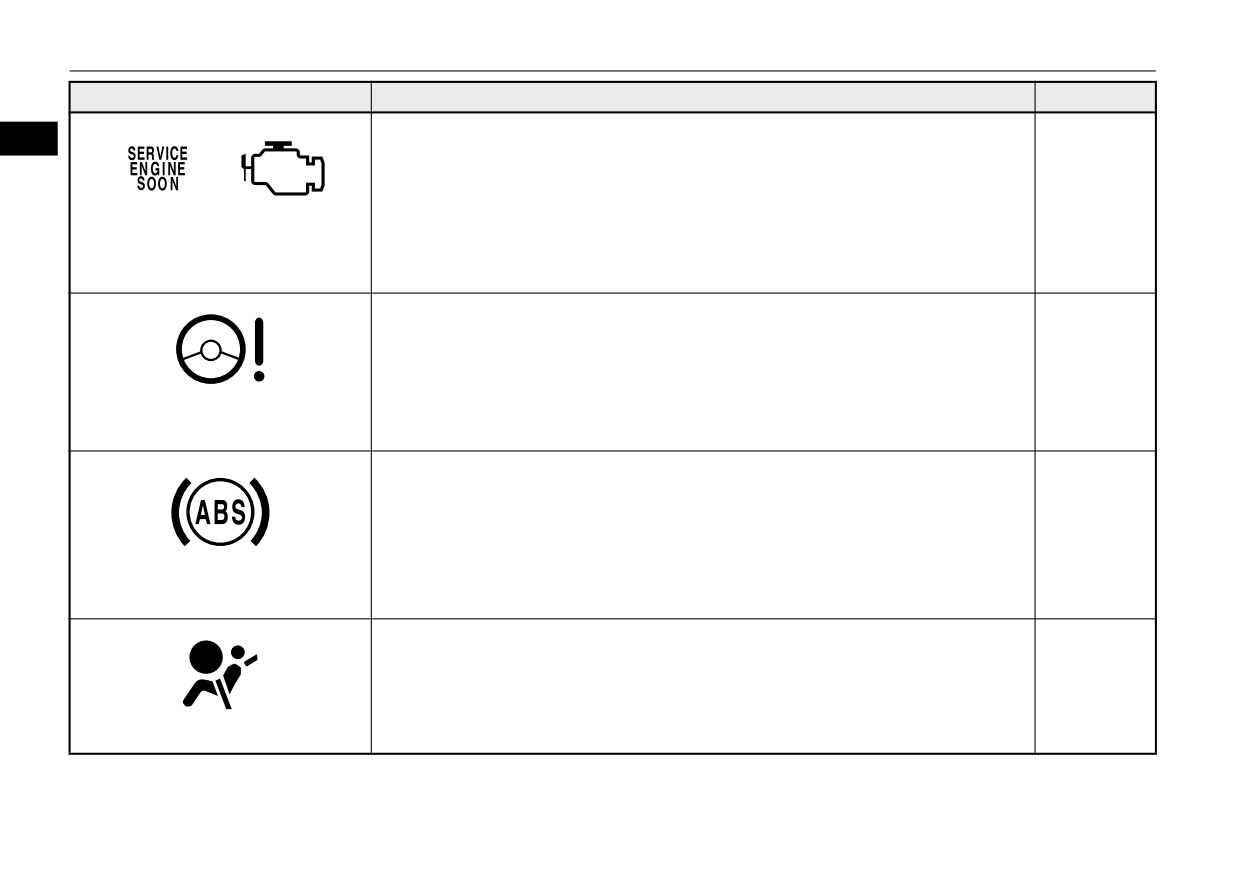
If this warning light comes on or flashes while you’re driving...
Warning lights
Do this
Ref. Page
2
z Although your vehicle will usually be drivable and not need towing, have the
or
engine system checked at an authorized Mitsubishi Motors dealer or a repair facility
of your choice immediately. If the vehicle is not drivable, contact emergency road-
P. 5-187
side assistance at 1-888-648-7820 (for vehicles sold in U.S.A.) or 1-888-576-4878
Engine malfunction indicator
(for vehicles sold in Canada), an authorized Mitsubishi Motors dealer, or local tow-
(“SERVICE ENGINE SOON” or
ing company for assistance.
“Check engine light”)
z If this light comes on while the engine is running, it may become harder to turn the
steering wheel. Have your vehicle inspected at an authorized Mitsubishi Motors
P. 5-84
dealer or a repair facility of your choice as soon as possible.
Electric power steering system (EPS)
warning light
z When this light comes on, the anti-lock braking system is not functioning and only
the ordinary braking system is functioning.
z Park your vehicle in a safe place and stop the engine.
Test the system as described on page 5-82.
P. 5-82
z If the light does not go out after the test, or if it comes on again, we recommend that
Anti-lock braking system warning
you have the system checked at an authorized Mitsubishi Motors dealer or a repair
light
facility of your choice as soon as possible.
z Immediately have the airbag and the pre-tensioner seat belt system checked at an
P. 4-37
authorized Mitsubishi Motors dealer.
SRS warning light
2-2
Quick index

If this warning light comes on or flashes while you’re driving...
Warning lights
Do this
Ref. Page
z
Park your vehicle in a safe place and stop the engine.
2
Restart the engine and check whether the indicator goes out.
z
If the indicator does not go out, or if it comes on again, have your vehicle inspected
and
by an authorized Mitsubishi Motors dealer or a repair facility of your choice as soon
P. 5-87
as possible.
z
When this indicator comes on, the active stability control is not functioning and
ASC indicator and ASC OFF indicator
normal operation of the vehicle will not be affected.
z
Park your vehicle in a safe place and stop the engine.
Restart the engine and check whether the indicator goes out.
z
If the indicator does not go out, or if it comes on again, have your vehicle inspected
by an authorized Mitsubishi Motors dealer or a repair facility of your choice as soon
P. 5-80
as possible.
z
When this indicator comes on, the hill start assist is not functioning.
ASC indicator
Start off carefully on a steep uphill slope.
z
If the warning light comes on, you should stop and adjust the tires to the proper
inflation pressure as soon as possible.
Refer to “Tire inflation pressures” on page 9-16.
Once adjustments have been made, the warning light will go off after a few minutes
of driving.
P. 5-126
z
If the warning light blinks for approximately 1 minute and then remains continu-
Tire pressure monitoring system warn-
ously illuminated, the system is not operating properly. If the system returns to nor-
ing light
mal, the warning light will go off. If the warning light does not go off, have the
vehicle inspected at an authorized Mitsubishi Motors dealer.
Quick index
2-3
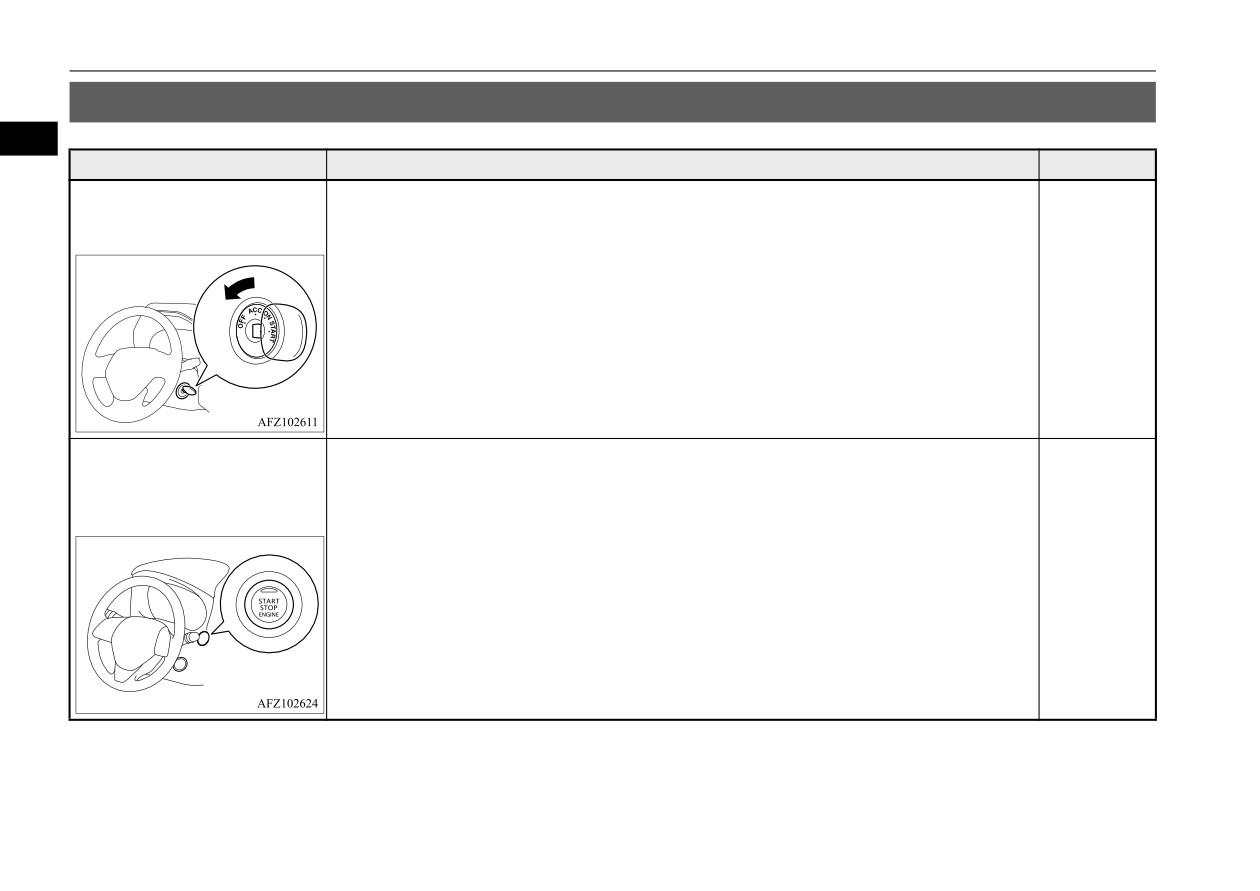
If this problem occurs...
If this problem occurs...
N00200902210
2
Problem
Do this
Ref. Page
Unable to turn the key.
(except for vehicles equipped
with the F.A.S.T.-key)
Will not turn from “ACC” to “OFF”.
Check the position of the selector lever.
P. 5-61
The key cannot be removed unless the selector lever is set to the “P” (PARK) position.
The engine does not start when
the engine switch is pressed.
(for vehicles equipped with the
F.A.S.T.-key)
Make sure the F.A.S.T.-key is in the vehicle.
Make sure the selector lever is in the “P” (PARK) position, and then press the engine switch
P. 5-23
while depressing the brake pedal.
2-4
Quick index

If this problem occurs...
Problem
Do this
Ref. Page
1. Move the selector lever to the “P” (PARK) position, and then change the operation mode
The engine does not start and the
2
to OFF.
operation mode cannot be
2. One of the other causes could be low battery voltage. If this occurs, the keyless entry sys-
P. 5-19
changed to OFF. (for vehicles
tem and the F.A.S.T.-key operation will also not operate. Contact an authorized Mitsubishi
equipped with the F.A.S.T.-key)
Motors dealer or a repair facility of your choice.
The F.A.S.T.-key does not oper-
ate.
Touch the portion of the F.A.S.T.-key to the engine switch, and then start the engine or change
P. 5-25,
(for vehicles equipped with the
the operation mode. Use the emergency key to lock and unlock the driver’s door.
5-26
F.A.S.T.-key)
Cannot shift the selector lever
Shift the selector lever while pressing the brake pedal.
P. 5-63
from the “P” (PARK) position.
Check that the ignition switch or the operation mode is in ON.
The windows are fogged up.
P. 7-3, 7-9,
Push the defogger switch to change to the “
” position.
7-13, 7-18,
7-22
The engine does not start.
The lights do not come on.
P. 8-2,
The lights are dim.
Have the battery checked. Recharge or replace as needed.
9-10
The horn does not honk.
The horn sound is weak.
Quick index
2-5
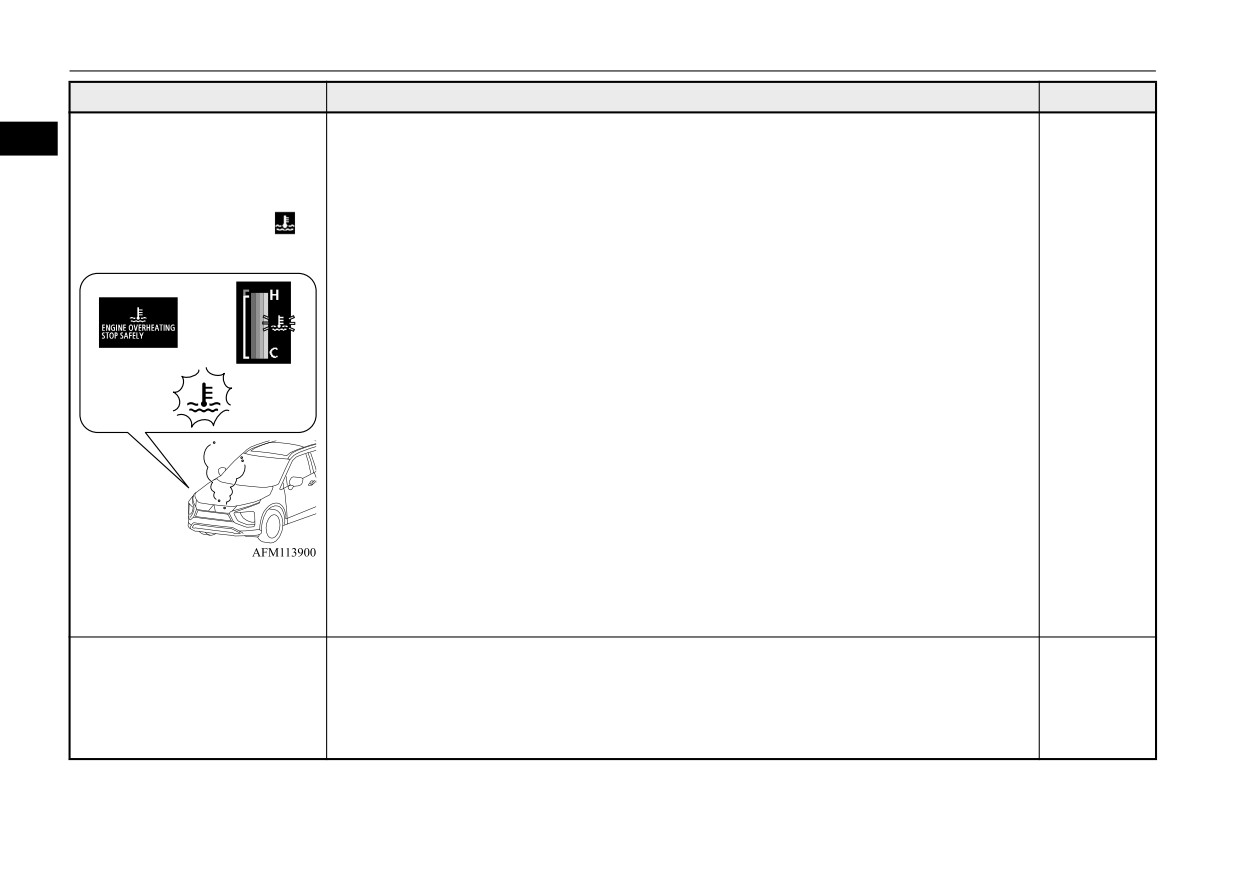
If this problem occurs...
Problem
Do this
Ref. Page
The information screen in the
2
multi-information display will
be interrupted and the engine
coolant temperature warning
display will appear. Also “
”
will blink.
The engine is overheated.
P. 8-4
Carefully stop the vehicle in a safe place.
Steam comes out of the engine
compartment.
1. Slowly press down on the accelerator pedal to get your vehicle moving again. For an all-
wheel drive vehicle, set the drive mode-selector to the “SNOW” or “GRAVEL” position
If your vehicle becomes stuck in
and then slowly press down on the accelerator pedal to get your vehicle moving.
P. 8-12
sand, mud or snow.
2. If there is nothing to stop your tires from slipping, rock your vehicle out of the stuck posi-
tion.
2-6
Quick index
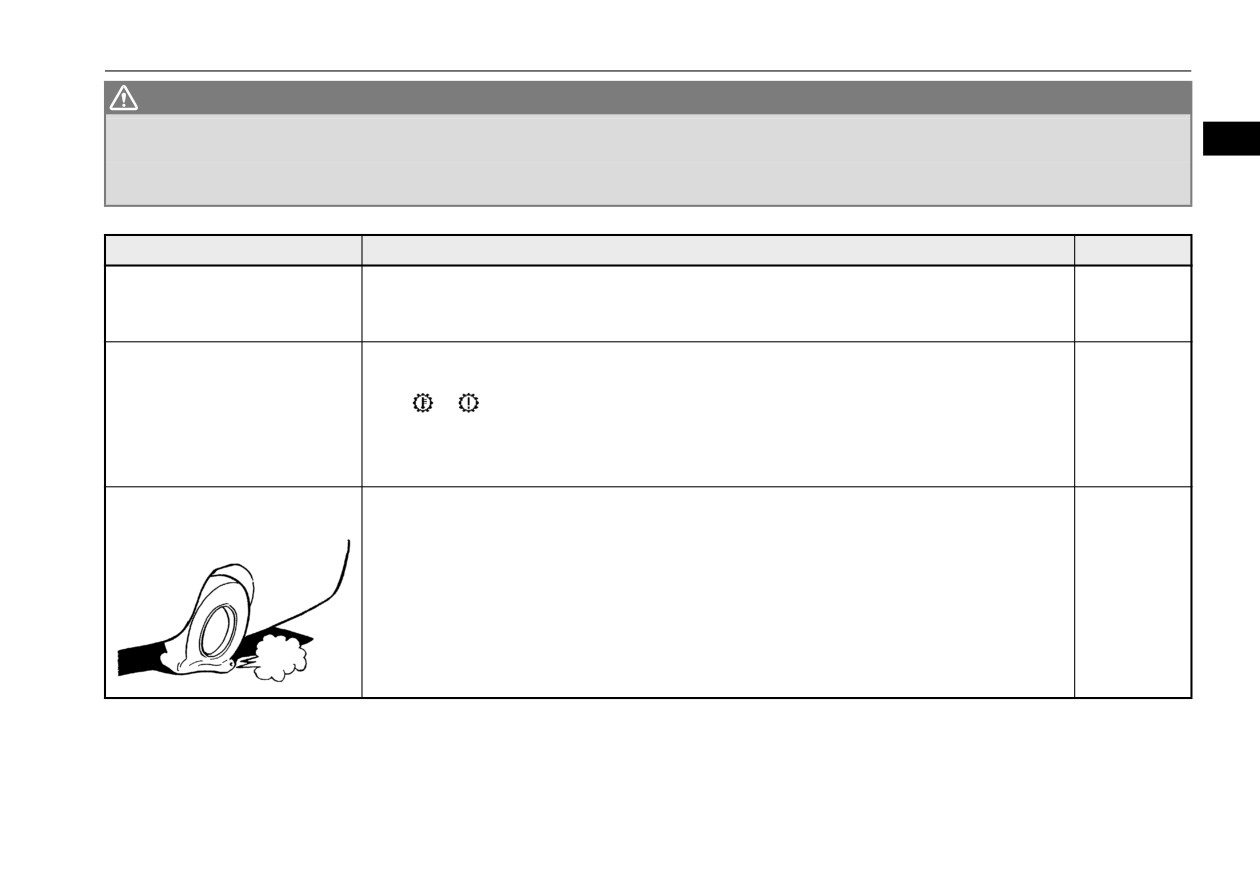
If this problem occurs...
WARNING
z When attempting to rock your vehicle out of a stuck position, be sure that no one is near the vehicle. The rocking motion may cause the vehicle to
suddenly lurch forward or backward, possibly injuring bystanders.
2
z Avoid revving the engine or spinning the wheels. Prolonged efforts to free a stuck vehicle may result in overheating and transaxle failure.
If the vehicle remains stuck after several rocking attempts, have a towing service pull the vehicle out.
Problem
Do this
Ref. Page
The brakes are not functioning
P. 5-74,
properly after crossing a puddle
Dry out the brakes by driving slowly while lightly pressing the brake pedal.
6-5
or stream.
The continuously variable trans-
mission (CVT) makes no shift
There may be a problem in the CVT.
change when accelerating. The
If the
or
warning display on the multi-information display will not turn off, or if they
P. 5-69
initial movement of the vehicle
come on frequently, immediately have the vehicle checked at your nearest Mitsubishi Motors
is slow when the vehicle starts
dealer.
moving.
A tire is punctured.
1. Park the vehicle in a safe place where the surface is flat and level.
P. 8-6
2. Replace the flat tire with the spare tire.
Quick index
2-7
General information
3
Fuel selection
3-2
Filling the fuel tank
3-3
Telematics Control Unit (TCU) (if so equipped)
3-5
Modifications to and racing of your vehicle
3-12
Genuine Mitsubishi Motors parts
3-13
California Perchlorate Materials Requirements
3-13
Break-in recommendations
3-14
Event Data Recording
3-14
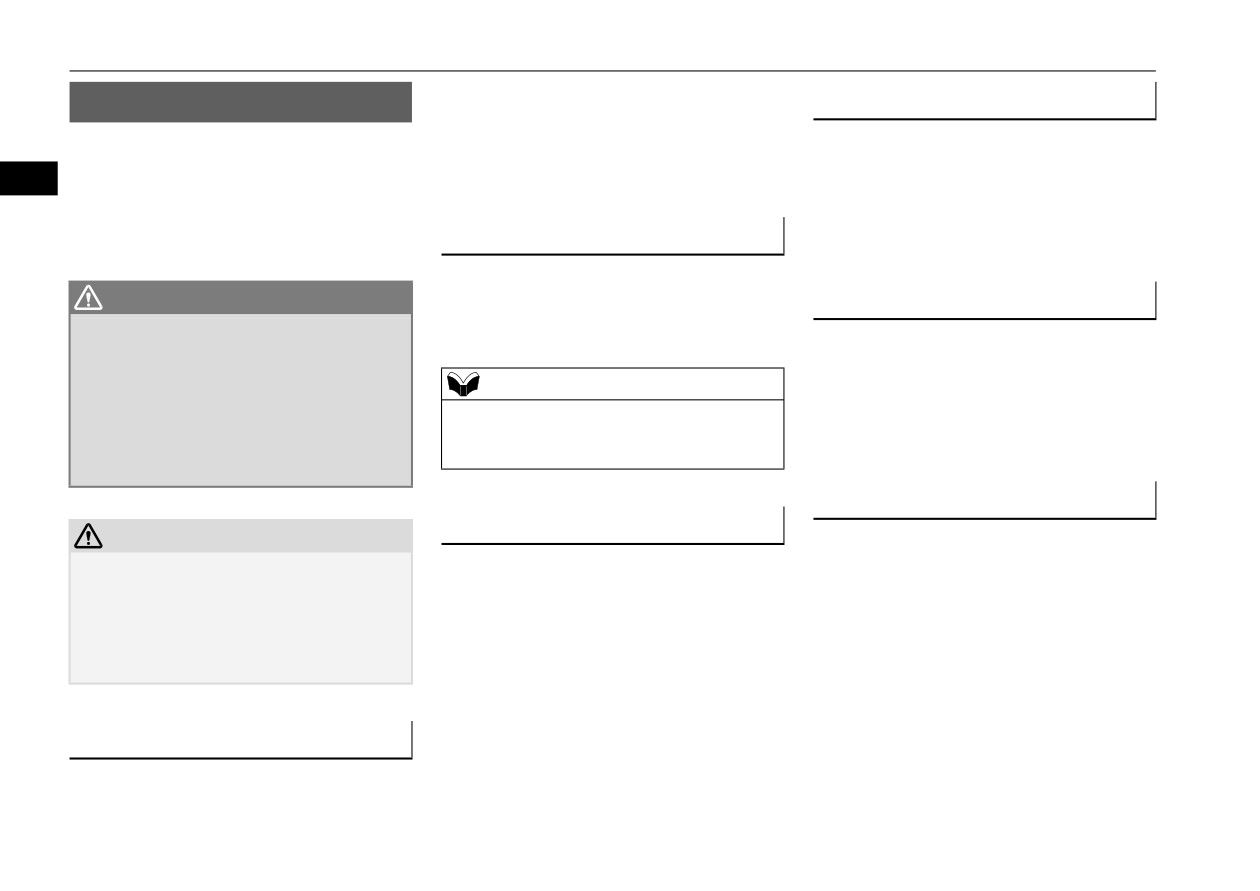
Fuel selection
oline to minimize fuel-injector clogging and
Fuel selection
Ethanol (Gasohol)
minimize intake-valve deposits. Detergent
N00301002059
gasoline helps keep your engine in tune and
Your vehicle is designed to use unleaded gas-
your emission-control system working prop-
A mixture of up to 10 % ethanol (grain alco-
oline only. It is equipped with a fuel tank
erly.
hol) and 90 % unleaded gasoline may be used
3
filler pipe specifically designed to accept only
in your vehicle, provided the octane number
a small diameter unleaded gasoline dispens-
is at least as high as that recommended for
Octane requirement
ing nozzle.
unleaded gasoline.
Your vehicle is designed to operate on
WARNING
Methanol
unleaded gasoline having a minimum octane
z
Gasoline is highly flammable and explo-
number of 87 [(MON+RON)/2] or 91 RON.
sive. You could be burned, seriously
Do not operate your vehicle on gasoline con-
injured or killed when handling it. When-
taining methanol (wood alcohol). Using this
ever you refuel your vehicle, stop the
NOTE
type of alcohol could adversely affect the
engine and keep flames, sparks, and
z Premium fuel is recommended to improve
vehicle’s performance and damage critical
smoking materials away from the vehicle.
the performance under severe conditions
parts of the vehicle’s fuel system.
Always handle fuel in well-ventilated out-
such as hot weather or towing.
door areas.
Reformulated gasoline
Oxygenated gasoline
CAUTION
Many areas of the country require the use of
z
Using leaded gasoline in your vehicle will
Gasoline sold at some service stations con-
cleaner burning fuel referred to as “Reformu-
damage the engine, catalytic converter, and
tains oxygenates such as ethanol, although
lated Gasoline”.
the oxygen sensors. Also, using leaded gaso-
the oxygenates may not be identified by those
Reformulated gasoline contains oxygenates
line is illegal, and will void your warranty
coverage of the engine, catalytic converter,
names. Oxygenates are required in some
and is specially blended to reduce vehicle
and oxygen sensors.
areas of the country. Oxygenated fuel can be
emissions and improve air quality.
used in your vehicle.
Mitsubishi Motors Corporation strongly sup-
ports the use of reformulated gasoline. Prop-
erly blended reformulated gasoline has no
Gasoline detergent additives
adverse effect on vehicle performance or the
durability of the engine and the fuel system.
In the United States, fuel suppliers are
required by law to add detergents to their gas-
3-2
General information
Filling the fuel tank
dealer may suggest using a different, lower-
MMT (methylcyclopentadienyl
Filling the fuel tank
sulfur brand of unleaded gasoline to deter-
manganese tricarbonyl)
N00301102092
mine if the problem is fuel-related.
WARNING
MMT is a manganese-containing metallic
3
NOTE
z
When handling fuel, comply with the
additive that is blended into some gasolines
z
Poor-quality gasoline can cause problems
safety regulations displayed by garages
to increase the octane number. Mitsubishi
such as hard starting, stalling during idling,
and filling stations.
Motors Corporation recommends using gaso-
abnormal engine noise, and poor accelera-
z
Gasoline is highly flammable and explo-
lines without MMT.
tion. If you experience any of these prob-
sive. You could be burned, seriously
Use of gasolines blended with MMT may
lems, try using a different brand of gasoline.
injured or killed when handling it. When
adversely affect performance, and cause the
If the engine malfunction indicator (“SER-
refueling your vehicle, always turn the
malfunction indicator on your instrument
VICE ENGINE SOON” or “Check engine
engine off and keep away from flames,
panel to come on. If this happens, contact an
light”) flashes, have the vehicle inspected
sparks, and smoking materials. Always
immediately by the nearest authorized
handle fuel in well-ventilated outdoor
authorized Mitsubishi Motors dealer or a
Mitsubishi Motors dealer or a repair facility
areas.
repair facility of your choice for assistance.
of your choice.
z
Before removing the fuel tank filler cap,
z
Repeatedly driving short distances at low
be sure to get rid of your body’s static
Sulfur in gasoline
speeds can cause deposits to form in the fuel
electricity by touching a metal part of the
system and engine, resulting in hard starting
vehicle or fuel pump. Any static electricity
and poor acceleration. If these problems
on your body could create a spark that
Your vehicle may have been designed to sat-
occur, you are advised to add a detergent
ignites fuel vapor.
isfy California’s low-emission regulations
additive to the gasoline when you refuel the
z
Perform the whole refueling process
based on clean-burning low-sulfur gasoline.
vehicle. The additive will remove the depos-
(opening the fuel tank filler door, remov-
Gasoline sold in parts of the country other
its, thereby returning the engine to a normal
ing the fuel cap, etc.) by yourself; do not
than California is allowed to have a higher
condition. Be sure to use a Mitsubishi
let any other person near the fuel tank
sulfur content. Using such gasoline could
Motors Genuine cleaning additive. Using an
filler. If you allowed a person to help you
adversely affect the vehicle’s catalytic con-
unsuitable additive could make an engine
and that person was carrying static elec-
malfunction. For details, please contact the
verter and cause the engine malfunction indi-
tricity, fuel vapor could be ignited.
nearest authorized Mitsubishi Motors dealer.
cator
(“SERVICE ENGINE SOON” or
z
Do not move away from the fuel tank filler
“Check engine light”) to come on. Illumina-
until refueling is finished. If you moved
tion of this indicator while using high-sulfur
away and did something else (for example,
sitting on a seat) part-way through the
gasoline does not necessarily mean the vehi-
refueling process, you could pick up a
cle’s emission-control system is malfunction-
fresh charge of static electricity.
ing. Your authorized Mitsubishi Motors
General information
3-3
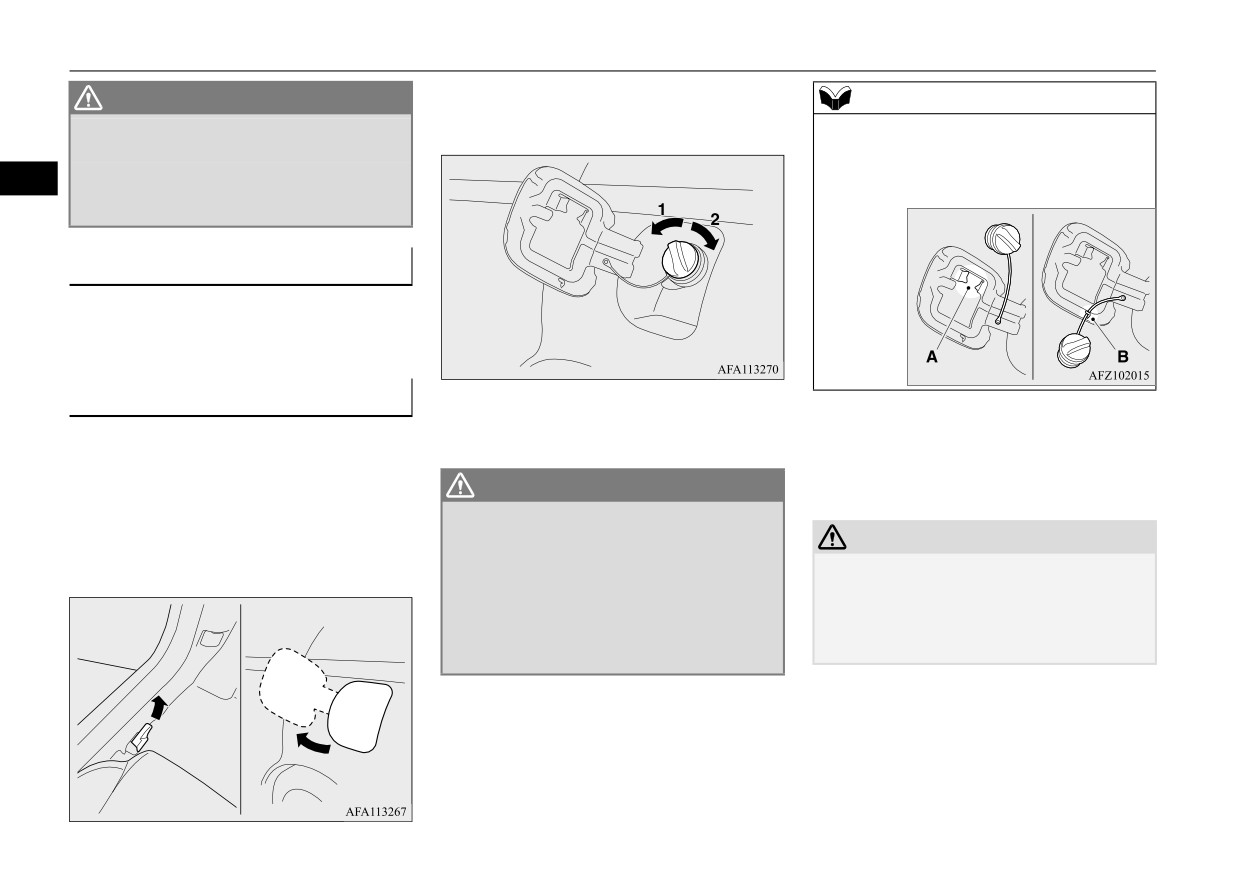
Filling the fuel tank
3. Open the fuel tank filler pipe by slowly
WARNING
NOTE
turning the fuel tank filler cap counter-
z Be careful not to inhale fuel vapor. Fuel
z While filling with fuel, store the fuel cap in
clockwise.
contains toxic substances.
the cap holder (A) or hang it on the hook (B)
z Keep the doors and windows closed while
located on the inside of the fuel tank filler
3
refueling the vehicle. If they were open,
door.
fuel vapor could get into the cabin.
Fuel tank capacity
All-wheel drive vehicles: 15.8 gal (60 L)
Front-wheel drive vehicles: 16.6 gal (63 L)
Refueling
1- Remove
2- Close
4. Fueling correctly depends mainly on cor-
1. Before filling with fuel, stop the engine.
rect handling of the fuel filler nozzle. Do
2. The fuel tank filler is located on the rear
not tilt the nozzle. Insert the nozzle in the
driver side of your vehicle.
WARNING
fuel tank filler port as far as it goes.
The fuel tank filler door can be opened
z Since the fuel system may be under pres-
from inside the vehicle with the fuel tank
sure, remove the fuel tank filler cap
CAUTION
filler door release lever located at the left
slowly. This relieves any pressure or vac-
z Your vehicle can only be operated using
side of the driver’s seat.
uum that might have built up in the fuel
unleaded gasoline. Serious engine and cata-
tank. If the cap is venting vapor or if you
lytic converter damage will result if leaded
hear a hissing sound, wait until the sound
gasoline is filled into these vehicles, and
stops before removing the cap. Otherwise,
consequently, this must never be attempted.
fuel may spray out, injuring you or others.
5. When the nozzle stops automatically, do
not add more fuel.
3-4
General information
Telematics Control Unit (TCU) (if so equipped)
CAUTION
NOTE
NOTE
z To avoid fuel spillage and overfilling, do not
z If the fuel tank filler cap is not tight while
z
To use the TCU, a user service agreement is
“top-off” the fuel tank. Spilled fuel could
driving, the engine malfunction indicator
necessary. In addition, you must install the
discolor, stain, or crack the vehicle’s paint-
(“SERVICE ENGINE SOON” or “Check
smartphone app, agree to the terms of ser-
work. If fuel spills on the paintwork, wipe it
engine light”) may come on when the
vice, and register as a user before using the
3
off with a soft cloth.
onboard diagnostic (OBD) system performs
TCU.
a self check.
For details including system limitations, con-
Always tighten the fuel tank filler cap until
tact an authorized Mitsubishi Motors dealer
6. To re-install, turn the fuel tank filler pipe
you hear at least 3 clicks.
or visit the Mitsubishi Motors website.
cap slowly clockwise until you hear click-
The indicator will go off after several driving
ing sounds, then gently push the fuel tank
cycles. If the indicator does not go off, con-
service/manuals
filler door closed.
tact your authorized Mitsubishi Motors
z
After you complete the registration using the
dealer or a repair facility of your choice
smartphone app, you will also be able to use
WARNING
immediately.
the telematics features on the owners portal
z
Make sure the fuel tank filler cap is
and call center service.
securely closed. If the fuel cap is loose, fuel
could leak, resulting in a fire.
Telematics Control Unit
SOS emergency assistance/
(TCU) (if so equipped)
Information assistance
CAUTION
N00302500057
z
If you need to replace the fuel tank filler cap,
The Telematics Control Unit (TCU) uses a
z SOS emergency assistance
use only a cap specified for your model vehi-
mobile communication network to transmit
If a collision is detected or you press the
cle.
notifications
(SOS emergency assis-
SOS switch (A), the system automatically
tance/Information assistance) in case of emer-
transmits the vehicle information to an
gency and vehicle information. The TCU also
emergency call center, and will call the
allows you to use your smartphone to operate
emergency call center, allowing you to
some vehicle functions remotely.
communicate the nature of your problem
or emergency and request assistance. If
necessary, the telephone call is forwarded
to a Public Safety Answering Point
(PSAP), such as dialing 911 in the United
States.
General information
3-5
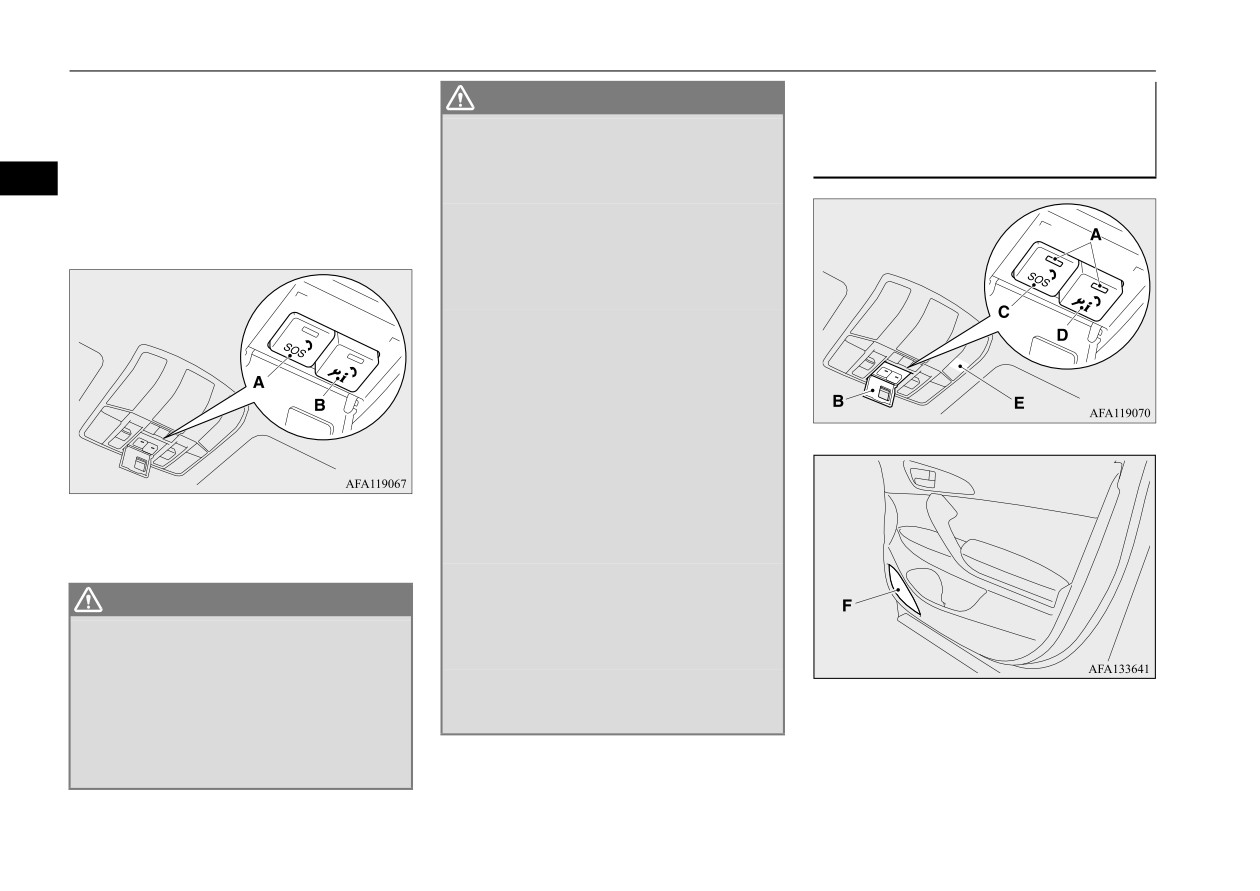
Telematics Control Unit (TCU) (if so equipped)
z
Information assistance
WARNING
Flow of the SOS emergency
If you press the information switch (B),
z
If an emergency occurs and you smell fuel
assistance/Information assis-
you will be connected to the call center
or other unusual odor, do not stay inside
and your vehicle information will auto-
tance
the vehicle. Exit the vehicle immediately
3
matically be transmitted to the call center.
and move to a safe location.
In the case of a breakdown, your tele-
z
While waiting for rescue after making the
phone call will be forwarded to roadside
emergency call, take actions to prevent a
assistance.
rear-end collision or other secondary acci-
dent and move to a safe location away
from the vehicle and traffic.
z
Always carry a cell phone or other com-
munication device as backup against pos-
sible
malfunctions or non-working
conditions in SOS emergency assistance.
This system should not be your sole means
of receiving help in the event of an emer-
gency.
In the following cases, use a cellular phone
or other device to call directly for an
emergency vehicle or road service.
A- SOS switch
• When the system does not operate due to
B- Information switch
a malfunction because of a collision, etc.
• When the vehicle is in a place where
radio waves cannot be transmitted or
WARNING
received, such as indoors, in an under-
z
In a country or area where no emergency
ground parking structure, in a moun-
call center is available for the TCU, or
tainous area, or in a tunnel.
where radio waves for the emergency call
• When the line to the emergency call cen-
cannot be transmitted or received nor-
ter is busy and the call cannot reach the
A- Indicator light (red/green)
mally, the system will not operate. In this
emergency call center.
B-
Cover
case, use a cellular phone, etc., to call
C-
SOS switch
directly for an emergency vehicle or road
D- Information switch
service.
E-
Microphone
F-
Door speaker (only front passenger side)
3-6
General information

Telematics Control Unit (TCU) (if so equipped)
[Automatic Report]
WARNING
WARNING
If your vehicle's airbags deploy or if the
z Do not remove or modify the above parts.
z
If the indicator lights (A) remain illumi-
unit detects that the vehicle was in a
This can cause the system to not operate.
nated or illuminate again after setting the
severe collision, your vehicle automati-
operation mode to ON, there is a possible
cally will attempt to connect to the emer-
3
problem in the system or the battery for
gency call center operator. Once
exclusive use of the TCU may be
NOTE
exhausted. The battery life is approxi-
connected, information about your vehi-
z Although the information switch (D) is not
mately 3 years.
cle, its location, and its condition will be
for use in emergencies, the operation is the
Have the system inspected or replace the
sent to the operator; you also can speak to
same as the operation of the SOS switch (C)
battery using an authorized Mitsubishi
the operator when connected.
for SOS emergency assistance.
Motors dealer.
[Manual Report]
z
When the system is not in the standby
When you open the cover (B) and press
1. After setting the operation mode to ON,
state, the system does not operate. When
the SOS switch (C).
the indicator lights
(A) illuminate for
you drive, make sure to check that the sys-
approximately 10 seconds. When approxi-
tem is in the standby state.
WARNING
mately 10 seconds has elapsed after the
z
Before pressing the SOS switch (C), stop
lights turn off, the system is in the standby
the vehicle in a safe place. If you operate it
state.
NOTE
while driving, your attention to the sur-
z
Even if the SOS emergency assistance is in
rounding conditions may be affected,
WARNING
the standby state, communication may not be
resulting in an accident.
possible for a while depending on the radio
z If the indicator lights do not illuminate
wave conditions.
after setting the operation mode to ON,
there is a possible problem in the system.
CAUTION
Have the system inspected by an autho-
2. The system operates by the following.
z
Do not open the cover unless you intend to
rized Mitsubishi Motors dealer.
press the SOS switch (C). You may press the
SOS switch (C) by mistake. In addition, if
the cover is left open while driving, the cover
can cause injury in the event of an accident.
General information
3-7
Telematics Control Unit (TCU) (if so equipped)
NOTE
WARNING
z Do not press the SOS switch (C) unless there
z
Do not replace the speakers. If they are
is an emergency such as an accident or sud-
replaced, the voice of the operator at the
den illness. If an emergency vehicle, such as
emergency call center may not be audible.
3
an ambulance, firetruck, or other official
If the speakers need to be replaced due to
response vehicle, is dispatched unnecessar-
a problem, or for any other reason, we
ily, you may be charged.
recommend you consult an authorized
Mitsubishi Motors dealer.
z
It is possible that an error may occur
3. The green indicator light blinks fast, the
between the actual location point of the
system calls the emergency call center,
vehicle and the location point that the
and the location and vehicle information
TCU reports to the call center. Confirm
are transmitted to the emergency call cen-
your location and description of your
ter.
vehicle through the call with the operator
of the emergency call center.
WARNING
z If the red indicator light illuminates as fol-
lows, directly arrange an emergency vehi-
NOTE
cle or road service with a cellular phone,
z
If the vehicle side microphone (E) and/or the
etc.
speakers fail, you cannot talk with the opera-
• When the red indicator light remains
tor of the emergency call center.
illuminated. (There is a possible problem
z
An emergency call cannot be disconnected
in the system.)
from the vehicle side.
• When the red indicator light illuminates
for 60 seconds. (The vehicle may be in
5. The emergency call center arranges for
the place where radio waves cannot be
transmitted and received.)
dispatch of the emergency vehicle as
required.
4. When the green indicator light changes
from a fast blinking state to a slow blink-
ing state, it is possible to speak with an
operator of the emergency call center.
3-8
General information
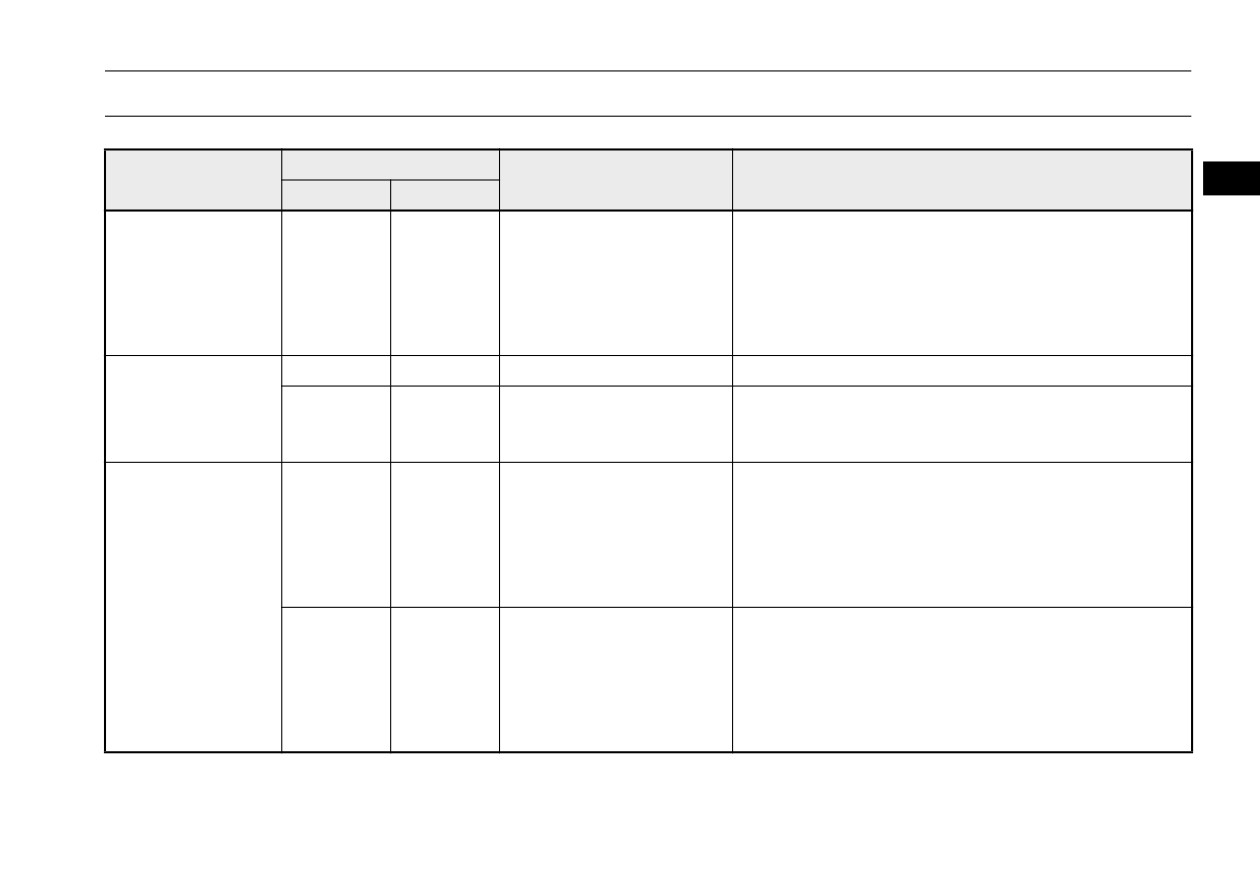
Telematics Control Unit (TCU) (if so equipped)
Indicator list
Indicator light
Situation
Cause
Solution
3
Red light
Green light
Wait for a while.
Illuminates
The indicator lights go off when the system check is com-
When changing the
(for approxi-
The system check is in pro-
plete.
operation mode to
Turns off
mately
cess.
If the indicator lights do not illuminate, there is a possible
ON
10 seconds)
problem in the system. In this case, immediately have the
system inspected at an authorized Mitsubishi Motors dealer.
After approximately
Turns off
Turns off
The system works normally.
í
10 seconds after
There is a possible problem
Immediately have the system inspected at an authorized
changing the opera-
Illuminates
Turns off
in the system or the battery
Mitsubishi Motors dealer.
tion mode to ON
may be exhausted.
z The system calls the
emergency call center.
Fast blink-
z The system transmits the
Turns off
í
ing
location and vehicle
While the SOS emer-
information to the emer-
gency assistance/
gency call center.
Information assis-
Mutually confirm the details of the SOS emergency assis-
tance is activated
tance/Information assistance with the operator of the emer-
It is possible to speak with an
Slow blink-
gency call center.
Turns off
operator of the emergency
ing
If the green light does not turn off even after the call ends,
call center.
have the system inspected at an authorized Mitsubishi
Motors dealer.
General information
3-9
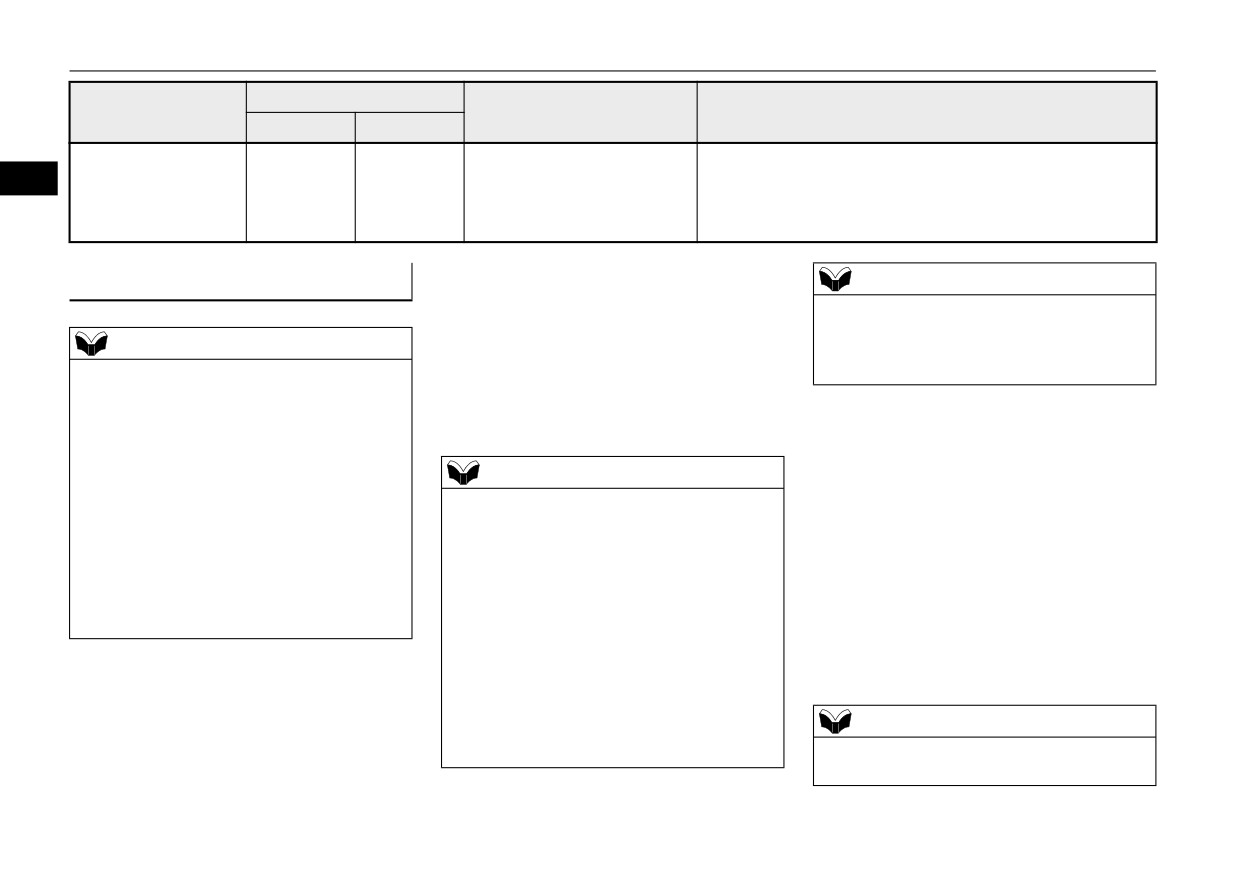
Telematics Control Unit (TCU) (if so equipped)
Indicator light
Situation
Cause
Solution
Red light
Green light
When the SOS emer-
Illuminates
The SOS emergency assis-
Activate SOS emergency assistance/Information assistance
3
gency assistance/
(for approxi-
Turns off
tance/Information assistance
again, or directly arrange an emergency vehicle or road ser-
Information assis-
mately
failed.
vice with the nearest public telephone, etc.
tance failed
60 seconds)
z
Stolen vehicle tracking
Remote control
NOTE
The vehicle tracking function can be used
z When the vehicle is locked or unlocked, the
by the call center to provide the vehicle
power-folding outside rearview mirrors
location information quickly to police.
NOTE
operate and the theft-alarm system turns on
z
Remote door lock/unlock
z
To operate the remote control functions from
or off.
The vehicle doors and liftgate can be
a smartphone or to receive notifications
locked and unlocked using the smart-
z
Remote climate control
using the smartphone, you must install the
phone app and the owner portal.
The engine can be started and the air con-
smartphone app and register as a user before-
hand. For details about using the functions or
ditioning can be operated using the smart-
changing the settings, visit the Mitsubishi
NOTE
phone app.
Motors website.
z
If the doors and the liftgate are unlocked
z
Car finder
using the smartphone app and the owner por-
The location of the parked vehicle can be
service/manuals
tal when no doors or the liftgate are opened
confirmed using the smartphone app.
z
The remote operation functions, other than
within a certain length of time, the doors and
z
Remote horn
the alert notification, cannot be activated if
the liftgate will automatically re-lock.
You can make the horn sound using the
the vehicle engine is not started for 5 or more
z
Be sure to have the F.A.S.T.-key with you
smartphone app.
consecutive days.
before locking the vehicle.
z
Remote lights
It is possible to lock/unlock the vehicle even
The lights can be turned on using the
when the F.A.S.T.-key is inside the vehicle.
z Alarm notification
smartphone app.
If the smartphone app cannot be used for
When the vehicle's theft-alarm system is
some reason (e.g., your smartphone battery
activated, an alert is sent to the smart-
NOTE
becomes discharged), you need the F.A.S.T.-
phone using a short message service
key in order to unlock the vehicle.
z The remote lights turns off automatically
(SMS), e-mail, or push notification.
after approximately 30 seconds.
3-10
General information
Telematics Control Unit (TCU) (if so equipped)
z
Speed alert
z Over The Air Update
NOTE
If you set a vehicle speed limit beforehand
When software and firmware updates are
• In hot sunshine
using the smartphone app and the owner
available, notifications will be sent to you
• In extremely cold weather
portal, an alert is sent to the smartphone
to install the updates. You can also check
z The remote climate control turns off auto-
app when the vehicle speed exceeds that
for available updates manually.
3
matically after approximately
10 minutes.
limit.
The remote climate control can be operated
z
Geofence
WARNING
up to two times consecutively.
If the specified area is set beforehand
z
Do not use the TCU if children, persons in
z Use the remote climate control according to
using the smartphone app and the owner
need of care, pets, etc., are in the vehicle.
the state or local regulations regarding idling
portal, an alert is sent to the smartphone
Even if the remote climate control is used,
vehicles.
using a short message service (SMS), e-
the cabin may become too hot or cold if
the system stops automatically or due to
mail, or push notification when the vehi-
any other reason. The cabin temperature
General information
cle enters or leaves that area.
may quickly rise with prolonged exposure
z
Curfew alert
to heat or sun, which may pose a risk of
If the specified time of day is set before-
Your TCU operates on a radio frequency sub-
heat stroke and dehydration. In cold
hand using the smartphone app and the
ject to Federal Communications Commission
weather, the cabin temperature may
owner portal, an alert is sent to the smart-
(FCC) Rules (for vehicles sold in U.S.A.).
quickly drop. Extreme changes in cabin
phone using a short message service
temperature may cause bodily harm,
This device complies with Part 15 of the FCC
(SMS), e-mail, or push notification when
injury, or death.
Rules. Operation is subject to the following
the curfew is violated.
In addition, children can activate switches
two conditions:
z Vehicle settings
and controls, resulting in an injury or
fatal accident.
z This device may not cause harmful inter-
You can change settings of items such as
ference.
“Auto Fold Mirrors” and
“Headlight
z This device must accept any interference
Timeout when Exiting Vehicle” from the
CAUTION
received, including interference that may
smartphone app and the owner portal.
z
When using the remote climate control, do
cause undesired operation.
z Vehicle Status Report (VSR)
not use a car cover.
The vehicle communication and informa-
tion regarding malfunctions can be trans-
CAUTION
mitted using the TCU so that the
z Changes or modifications made to this
NOTE
condition of the vehicle can be checked
equipment not expressly approved by the
z
Air conditioning performance may deterio-
using the smartphone app and the owner
manufacturer may void the FCC authoriza-
rate under the following conditions:
portal.
tion to operate this equipment.
• In extremely hot weather
General information
3-11
Modifications to and racing of your vehicle
FCC Notice: This equipment has been tested
z Modification of any onboard com-
Modifications to and racing
and found to comply with the limits for a
puter/control module, including repro-
Class B digital device, pursuant to part 15 of
of your vehicle
gramming, or replacing/adding chips to
the FCC Rules. These limits are designed to
N00301601218
any onboard computer/control module
3
provide reasonable protection against harmful
This vehicle should not be modified with
interference in a residential installation.
Review the Warranty and Maintenance Man-
non-Mitsubishi Motors genuine parts.
This equipment generates, uses and can radi-
ual for further details regarding warranty cov-
Mitsubishi Motors designs and manufactures
ate radio frequency energy and, if not
erage.
high quality vehicles with an emphasis on
installed and used in accordance with the
safety and durability. Modifications using
instructions, may cause harmful interference
non-Mitsubishi Motors genuine parts may
Installation of accessories
to radio communications.
affect the performance, safety and/or durabil-
N00301701293
However, there is no guarantee that interfer-
ity of your vehicle, and may violate applica-
ence will not occur in a particular installation.
ble state and/or federal regulations.
CAUTION
If this equipment does cause harmful interfer-
z
Before any electrical or electronic accesso-
ence to radio or television reception, which
DAMAGE OR PERFORMANCE PROB-
ries are installed, consult an authorized
can be determined by turning the equipment
LEMS RESULTING FROM MODIFICA-
Mitsubishi Motors dealer.
off and on, the user is encouraged to try to
TIONS TO OR RACING OF YOUR
z
Your vehicle is equipped with a diagnosis
correct the interference by one or more of the
VEHICLE ARE NOT COVERED
connector (data link connector) for checking
following measures:
UNDER WARRANTY.
and servicing the electronic control system.
Mitsubishi Motors does not recommend con-
z Reorient or relocate the receiving antenna.
Examples of modifications to your vehicle
necting a device other than the Scan Tool for
z Increase the separation between the
that can cause damage or performance prob-
inspections and service to this connector
because an unexpected problem could result.
equipment and receiver.
lems include the following:
In addition, malfunctions caused by connect-
z Connect the equipment into an outlet on a
ing a device other than the Scan Tool may
circuit different from that to which the
z Failure to use Mitsubishi Motors genuine
not be covered under warranty.
receiver is connected.
parts
z Consult the dealer or an experienced
z Failure to use required fuel and fluids
z Failure to use proper size tires and wheels
z
The installation of accessories, optional
radio/TV technician for help.
z Modification of the fuel, intake, exhaust,
parts, etc., should only be performed
emission, suspension, engine, drive train
within the limits prescribed by law, and in
or electrical wiring systems
accordance with the guidelines and warn-
ings contained within the documents
accompanying this vehicle.
3-12
General information
Genuine Mitsubishi Motors parts
Only Mitsubishi Motors approved acces-
Important point!
Genuine Mitsubishi Motors
sories should be fitted to your vehicle.
z Improper installation of electrical parts
parts
Due to the large number of accessory and
could cause a fire. Refer to the “Modifica-
N00301400219
replacement parts provided by different man-
tion/alterations to the electrical or fuel
3
Mitsubishi Motors Genuine Parts are
ufacturers in the market, it is not always pos-
systems” section within this owner’s
designed and manufactured to meet high stan-
sible for an authorized Mitsubishi Motors
manual.
dards of performance, and are recommended
dealer to check whether the attachment or
z Using a cellular phone or radio set inside
for all of your maintenance needs. Also avail-
installation of a non-Mitsubishi Motors genu-
the vehicle without an external antenna
able from your Mitsubishi Motors dealer are
ine parts affects the driving safety of your
may cause electrical system interference,
a wide variety of accessories to personalize
vehicle.
which could lead to unsafe vehicle opera-
your new vehicle. Each Mitsubishi Motors
tion.
vehicle has a selection of Mitsubishi Motors
z Tires and wheels which do not meet spec-
Modification/alterations to the
authorized accessories to choose from to tai-
ifications must not be used.
electrical or fuel systems
lor your new vehicle to your own personal
Refer to the “Specifications” section for
N00301800141
preference. Your Mitsubishi Motors dealer’s
information regarding wheel and tire
Parts Manager has information on various
Mitsubishi Motors manufactures high quality
sizes.
audio systems, protection items, as well as
vehicles with an emphasis on safety. It is
interior and exterior accessories available for
important to consult an authorized Mitsubishi
WARNING
your specific model.
Motors dealer before installation of any
z
While driving, do not use a cellular phone
accessory which may involve modification of
in a way that hinders safe driving. Any-
the electrical or fuel systems.
California Perchlorate
thing, including cellular phone usage, that
distracts you from the safe operation of
Materials Requirements
your vehicle increases your risk of an acci-
CAUTION
N00300100017
dent.
z Please consult an authorized Mitsubishi
Certain components of this vehicle, such as
Refer to and follow all state and local laws
Motors dealer concerning any such acces-
airbag modules, seat belt pretensioners, and
in your area regarding cellular phone
sory fitment or modification.
button cell batteries, may contain perchlorate
usage while driving.
If the wires interfere with the vehicle body or
improper installation methods are used (pro-
materials.
tective fuses not included, etc.), electronic
Special handling may apply. For additional
devices may be adversely affected, resulting
information, see www.dtsc.ca.gov/
in a fire, vehicle damage, or other accident.
hazardouswaste/perchlorate.
General information
3-13
Break-in recommendations
Break-in recommendations
Event Data Recording
NOTE
N00302600029
N00302700059
z EDR data are recorded by your vehicle only
if a non-trivial crash situation occurs; no data
Advanced automobile manufacturing tech-
This vehicle is equipped with an event data
are recorded by the EDR under normal driv-
3
niques permit you to operate your new vehi-
recorder (EDR).
ing conditions and no personal data (e.g.,
cle without requiring a long break-in period
The main purpose of an EDR is to record, in
name, gender, age, and crash location) are
of low-speed driving.
certain crash or near crash-like situations,
recorded. However, other parties, such as
However, you can add to the future perfor-
such as an airbag deployment or hitting a
law enforcement, could combine the EDR
mance and economy of your vehicle by
road obstacle, data that will assist in under-
data with the type of personally identifying
observing the following precautions during
standing how a vehicle’s systems performed.
data routinely acquired during a crash inves-
the first 300 miles (500 km).
The EDR is designed to record data related to
tigation.
Drive your vehicle at moderate speeds during
vehicle dynamics and safety systems for a
the break-in period.
short period of time, typically 30 seconds or
To read data recorded by an EDR, special
less.
equipment is required, and access to the vehi-
z
Avoid revving the engine.
cle or the EDR is needed. In addition to the
z
Avoid rough driving such as sudden starts,
The EDR in this vehicle is designed to record
vehicle manufacturer, other parties, such as
sudden acceleration, prolonged high-
such data as:
law enforcement, that have the special equip-
speed driving and sudden braking. These
ment, can read the information if they have
actions would have a detrimental effect on
z How various systems in your vehicle were
access to the vehicle or the EDR.
the engine and lead to increased fuel and
operating;
oil consumption; this could ultimately
z Whether or not the driver and front pas-
result in the malfunction of engine com-
senger safety belts were buckled/fastened;
ponents. Be particularly careful to avoid
z How far (if at all) the driver was depress-
full acceleration while in low shift posi-
ing the accelerator and/or brake pedal;
tion (low gears).
and,
z
Do not overload the vehicle. Stay within
z How fast the vehicle was traveling.
the seating capacity.
These data can help provide a better under-
Refer to
“Cargo load precautions” on
standing of the circumstances in which
page 6-11.
crashes and injuries occur.
z
Refrain from towing a trailer or other
vehicle.
Refer to “Trailer towing” on page 6-13.
3-14
General information
///////////////////////////////////////